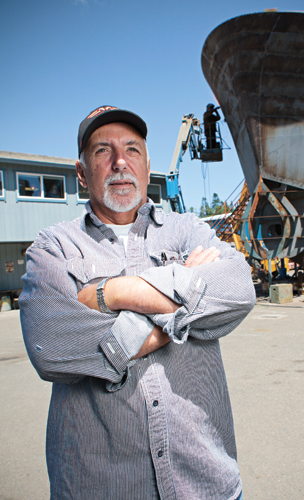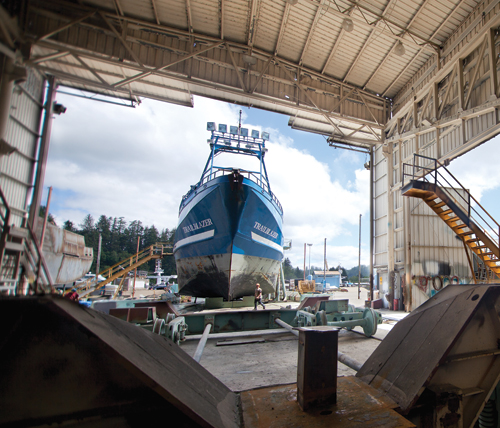 For Fred Wahl, the best part of building commercial fishing boats for a living is rolling his finished products, painted and polished, down to the water along the northeast edge of his Reedsport boatyard and seeing them pop half an inch off their cradles for the first time, floating.
For Fred Wahl, the best part of building commercial fishing boats for a living is rolling his finished products, painted and polished, down to the water along the northeast edge of his Reedsport boatyard and seeing them pop half an inch off their cradles for the first time, floating.
BY CHRISTINA COOKE
 |
Fred Wahl in front of his latest creation, the Isle Dominator.// Photo by Adam Wickham |
For Fred Wahl, the best part of building commercial fishing boats for a living is rolling his finished products, painted and polished, down to the water along the northeast edge of his Reedsport boatyard and seeing them pop half an inch off their cradles for the first time, floating.
“Then it’s a boat,” Wahl says. “Before that it’s a pile of parts. Launching a boat is like starting a new little life.” Over 24 years in the business, Wahl has seen 39 boats go buoyant — including a record three already this year.
In a state where high-tech companies get most of the attention, the idea of a shipyard may strike many as antiquated. But Wahl has responded to the technological and regulatory changes in the fishing industry and carried the age-old craft of building boats into the 21st century. As one of the only boatyards in Oregon still constructing new vessels — and the operation responsible for about 70% of the new fishing fleet in Alaska since 2000 — Fred Wahl Marine Construction is faring particularly well these days.
On a sunny May morning, wearing pointed-toe cowboy boots, Wahl walks across the 7-acre shipyard near the mouth of the Umpqua River, just downstream from the Schooner Inn Cafe. The place bustles with activity as his crew puts final touches on the three new boats for the summer fishing season and welds steel plates to the frame of the newest project, the Isle Dominator.
While some of Wahl’s creations fish off California, Oregon and Washington, three-quarters work the cod, halibut and sable fisheries in Alaskan waters, where they have to carry massive loads and withstand cold, harsh conditions.
Born in Depoe Bay in 1947, Wahl has lived on the Oregon Coast his entire life. He started helping out with his father’s fix-it business at the age of 12 but left home at 15 and never finished high school. He constructed crab pots, built boat hulls and beat the docks in Alaska with his welding equipment, doing repair work before building his first fishing boat on commission in his hometown in 1988.
When Wahl first entered the business, he had plenty of company. Up and down the Oregon and Washington coast, shipyards were turning out trawlers, seiners and crab boats at a rapid pace. But in 1991, around the time Wahl moved his Depoe Bay operation to the current Reedsport property, the boat-building heyday of the previous decades screeched to a halt: the boom had filled the waters to capacity, and a license-limitation program that restricted the number of boats permitted in Alaskan fisheries took effect, squelching demand for new vessels. As a result, many Pacific Northwest boatyards folded or turned their focus to repairs.
“All through the ’90s it was really slim,” Wahl says. “In the second half of the ’90s, we would try to get a boat every year. But no one else on the West Coast hardly at all was building any boats.”
{artsexylightbox singleImage=”/images/stories/articles/archive/july2013/slideshow-intro-fredwahl.jpg” path=”/images/stories/articles/archive/july2013/fredwahl/”}{/artsexylightbox}
 |
A view of the Trailblazer from the company warehouse// Photo by Adam Wickham |
The industry began to revive around 2005, says Hal Hockema, a naval architect for Seattle-based Hockema & Whalen Associates. The favorable exchange rate for U.S.-caught fish and the premium on wild salmon made commercial fishing a lucrative occupation once again, as did the strategic fisheries management via federal- and state-set quotas.
“Wahl stayed with it while others dropped out, and now that the market is coming back, he’s in a good position to meet it,” Hockema says. “He’s kind of a last man standing.” Staffed by about 75 employees, Fred Wahl’s shipyard can construct a boat in six to seven months and, unlike most others, fabricates all its own tools from scratch, welding together everything from cranes to anchor winches to shaft couplings.
Wahl’s specialty boat to date is the Arctic Fox, a 58-foot design he developed in 2007 and has replicated a dozen times. The seiner fits the regulatory length limits of Alaskan fisheries but compensates by being as wide and deep as possible.
Commercial fisherman Matt Giambrone, whose 58-foot Magnus Martens is one of the three new boats headed for Alaska this season, says the design squeezes maximum performance out of the length limit. The boat can hold a lot of gear and 200,000 pounds of fish at once, which reduces the number of port trips needed to unload.
“It used to be, to pack that much fish, you’d be looking at a boat that was 80 feet long,” Giambrone says.
To meet a need he predicts will arise in coming years, Wahl recently designed and built a 114-foot stainless steel crabbing vessel called the Victory. His largest boat yet — and hopefully (depending on demand) a prototype for many more to come — the Victory will take on the Bering Sea this summer.
While Wahl’s shipyard is currently busier than ever, Wahl’s son Mike, who started as a purchasing agent when he was 20 and now oversees the yard day-to-day, says he cannot predict what the future will bring. He does know one thing for sure, though: “The good old days are right now,” he says. “We’re rolling through them.”

